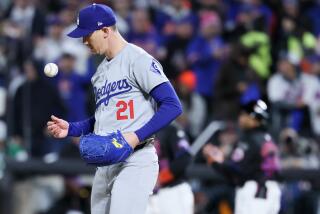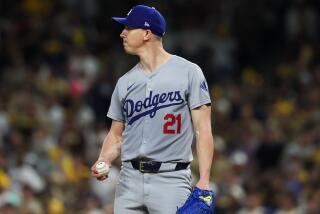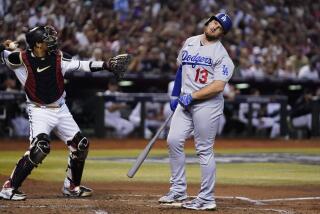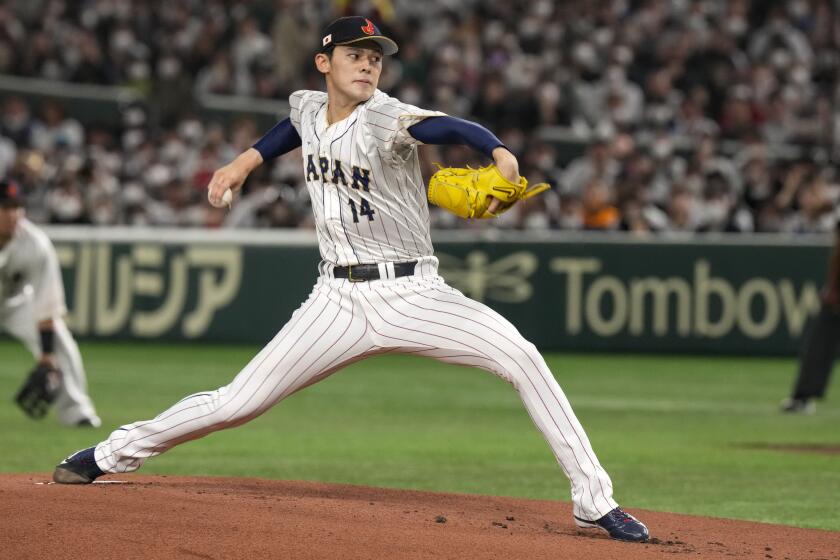Dodgers pitcher Ross Stripling making most of chance at starting
Reporting from pittsburgh — One day last month, as Ross Stripling eased into the Dodgers starting rotation, he fell into conversation with pitching coach Rick Honeycutt about his curveball.
For Stripling, the curve could be unruly. The pitch escapes his hand at the relatively brisk speed of 81 mph before tumbling as many as 10 inches downward on a vertical plane. To tame it, Stripling felt he needed to slow his arm during his delivery. In a bullpen session, Honeycutt offered a suggestion, one which Stripling cited as a source for his recent strikeout-laden dominance.
“Why don’t you just throw it as hard as you can?” Honeycutt said. He referenced how Sandy Koufax threw his curveball. He mentioned modern examples, such as Clayton Kershaw and Rich Hill, who overwhelm hitters with the ferocity, not the accuracy, of their off-speed pitches. The great ones, Honeycutt explained, throw the curveball as hard as possible aimed toward the center of the plate.
“I was like ‘Alright, I’ll give it a go,’” Stripling said.
Stripling, a 28-year-old right-handed pitcher, excels at absorbing information. He also understands how to capitalize on an opportunity. He holds a Series 7 license as a stockbroker and still trades for Wunderlich Securities. Most mornings he studies the markets while scanning for news on sources ranging from Yahoo Finance to President Trump’s Twitter feed. He calls his boss in Houston to strategize for a couple of hours before heading to the ballpark. He manages the portfolios of his brother and his father but has been unable to convince his Dodgers teammates to invest with him.
Even so, Stripling maintained, “I’ve had a good year.”
The same qualifier applies to his pitching. As injuries sidelined four members of the opening-day rotation, Stripling (3-1, 1.68 earned-run average) has excelled in the role he longed to fill last season. In his last four outings heading into Tuesday’s start against the Pittsburgh Pirates, Stripling has struck out 35 batters in 25 innings and permitted only four earned runs. Along with rookie Walker Buehler, he is part of the reason the rotation ranked sixth in the majors in ERA before Monday’s games.
As a rookie in 2016, Stripling started for the Dodgers for two months before fading into the bullpen. Manager Dave Roberts credited three factors for Stripling’s recent relative renaissance: an improved physique, an increased familiarity with big-league hitters and a more nuanced sense of how his four-pitch arsenal plays at this level.
“Going into this season, he’s got a lot of clarity,” Roberts said. “He’s holding his stuff. And Ross is just a pro. In every sense of the word.”
Stripling started only two games in 2017. He was relegated to a role as a reliever used for multi-innings stints. The team did not trust him in high-leverage spots in the postseason. His appearance in Game 2 of the World Series, a four-pitch walk, started the chain of events that led to the Houston Astros tying the game and tying the series.
As 2018 began, Stripling entered the spring in the same role. He had received repeated assurances from president of baseball operations Andrew Friedman that the organization believed in him as a starter. Yet he was sixth on a depth chart where five men pitch. His friends back in Texas pestered him about whether he would be a reliever for the rest of his career. He wondered how he might fare as a full-time starter on a less-talented team.
“I would be lying to you if I said I didn’t think about that,” Stripling said. “But I certainly don’t want to go on the record as saying like ‘I wish I got traded.’ Because that’s not where I was. What I wanted was another chance to start. I felt like that was definitely slipping away here.”
A cascade of ailments opened a door. He made an emergency start on April 30 when Rich Hill developed an infection in his finger. A couple of weeks later, Stripling received a temporary invitation to the rotation. When the Dodgers needed someone to pitch as Kershaw dealt with biceps tendinitis in early May, Stripling got the nod on one day’s notice.
Stripling threw four scoreless innings against San Diego on May 6. He struck out seven Cincinnati Reds in his next outing. He listened to Honeycutt’s advice about his curveball and accelerated his arm speed. The pitch became weaponized as hitters mistook it for his 93-mph fastball.
“Their eyes pick up on stuff, man,” Stripling said. “And they can see if it’s 5% less effort. And all of a sudden, now I’m torquing it at the same speed as my heater, and throwing the high heater off of that. I think it’s just messing with their eye level. It just has more intensity behind it.”
The curveball can finish at-bats. So can his slider. His change-up disarms left-handed hitters. The mix of off-speed choices allows him to avoid leaning on his fastball. Stripling uses fastballs 38.5% of the time, the 11th-lowest percentage among the 132 pitchers who have thrown at least 40 innings this season.
“There’s not a lot of noncompetitive pitches,” catcher Austin Barnes said. “He’s throwing everything with a purpose, and I think it’s shown with his results.”
Stripling can be analytical about his approach and forthright about his vulnerability. On several occasions, he has admitted about being unsure about his ability to conquer big-league hitters. Inside the cloistered environment of a clubhouse, his candor stands out.
After Stripling struck out nine Philadelphia Phillies on May 30, Justin Turner joked about how long Stripling’s post-game interview would last. He set the line at 15 minutes. (Stripling finished up after 13.) Near the end, Stripling relayed Honeycutt’s advice about altering the usage of his breaking ball, while catcher Yasmani Grandal walked by within earshot.
“You going to give Pittsburgh the whole scouting report, too?” Grandal huffed as he entered the shower. “Unbelievable,” he grumbled.
The outburst cracked up Barnes and Buehler, who were nearby. It amused Stripling.
“I was like, ‘Dude, I think people know I have a curveball,’” Stripling said.
Stripling remembers how his strength dwindled in the second half of 2016. He said he had added about 20 pounds to his frame since then, bulking up to 220. At the end of a road trip to Miami and Washington, Stripling noticed he had lost a couple of pounds. Brandon McDaniel, the strength and conditioning coach, advised him to “gorge for a week,” Stripling said. He chomped on cookies in the dugout to maintain mass.
The adjustments are sure to continue. Stripling intends to be ready for them. He understands that as a member of the Dodgers pitching staff, a demotion to the bullpen is only a couple of mediocre outings away, even with injuries depleting the reserves.
“I still feel like I have to prove it,” Stripling said. “I think you have to have the mentality that this is an opportunity that is not something I can take for granted.”
Twitter: @McCulloughTimes
More to Read
Are you a true-blue fan?
Get our Dodgers Dugout newsletter for insights, news and much more.
You may occasionally receive promotional content from the Los Angeles Times.









